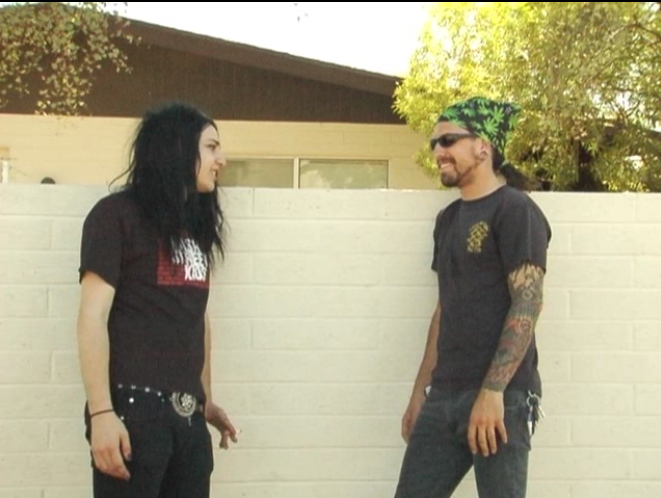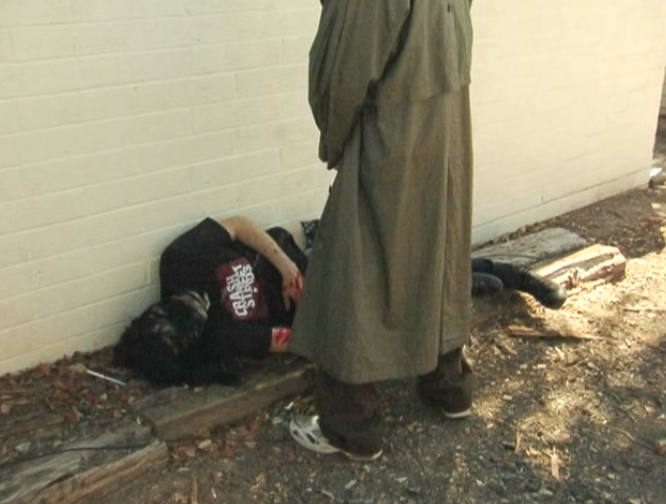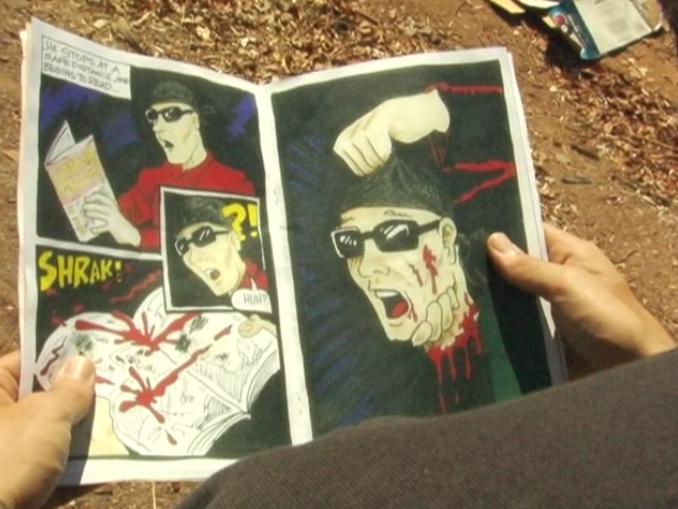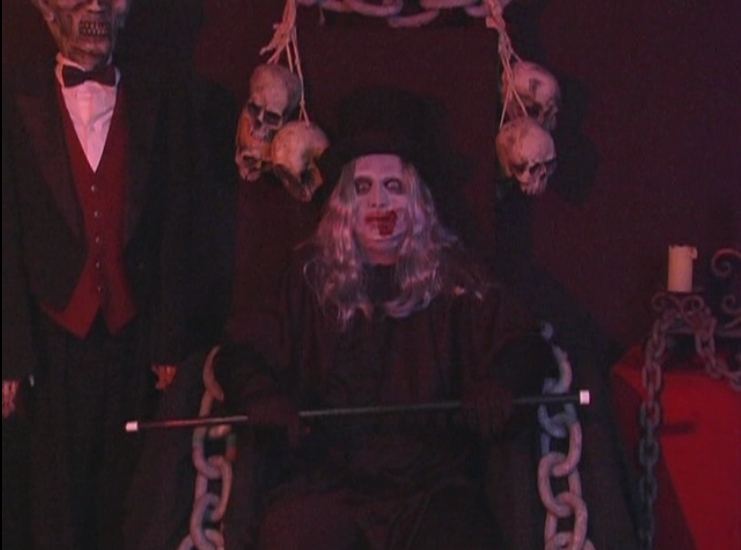A HERO: ah, okay
I'll do an impassioned defense of prince of darkness as recompense
A FOOL: :p
why are you doing it, again?
THE HERO: what doo you mean
MINDLESS: who are you defending PoD from?
EZEKIEL: the haters
guess you don't understand internet
The more I think about it, the more I think that Prince of Darkness, Carpenter's sullen middle child in the Apocalypse Trilogy, is my favorite Carpenter film. This isn't some underhanded complement of Carpenter's other films, but rather the extent to which I fucking love Prince of Darkness. Unfortunately, most tiresome horror nerds will blather about whether Halloween or The Thing is the best, and consign Prince of Darkness to "yeah it was pretty silly" and depending on whether we're dealing with hipster horror nerds or not, someone will point out that DJ Shadow argh fuck all of you.
I'm going to go on record here. I believe that, especially with Carpenter slowly oozing back into cinema (I am literally too scared to see his newest films, especially with the vague hope that his "Masters of Horror" run means NO MORE CHILDREN OF THE DAMNED EVER FUCKING AGAIN), there will be a critical reevaluation of Prince of Darkness. The basic critical line on the film goes from viewing it positively as a wacky, silly, occasionally scary spookfest and negatively as a too wacky mess with a boring cast.
Generally, I've seen people express the "plot is too goofy" argument by restating the plot in a tone typically reserved for eye-rolling college professors talking about science fiction. "Oh, so there's a big green vat of liquid, and that's the ultimate evil, and it possesses people by pouring green stuff in their mouth. Riiiiight." It's sort of the offensive version of when writers try to explain their story outline to you and stop out of embarrassment. STOP THE PRESSES, WEIRD IDEAS SOUND PRETTY STUPID WHEN OUT OF THEIR ELEMENT. Sure, the Possession by Ecto Cooler is silly no matter how you look at it, but it's also not entirely out of place in this sort of movie, which attempts to conflate absurd concepts with a genuine sense of dread.
"From Job's friends insisting that the good are rewarded and the wicked punished, to the scientists of the 1930's proving to their horror the theorem that not everything can be proved, we've sought to impose order on the universe. But we've discovered something very surprising: while order DOES exist in the universe, it is not at all what we had in mind!"
Generally, when horror movies attempt to introduce intellectual concepts in their film, they have to dress it up in the most obvious clothes possible to make it clear that HEY THIS SCARY IS SUPPOSED TO BE SMART. There's nothing smarter in Cemetery Man than in Prince of Darkness, but because the former makes it very clear that its an arthouse film, and the latter masquerades itself in genre conventions, idiot critics who are more interested in fellating Fellini miss the point. Putting it another way, alot of people attack Prince of Darkness because the weird things aren't weird enough to register as truly thematic. But if the film went for the truly grotesque, it would undermine the movie's tone, of ordinary becoming something still within intellectual grasp, but ultimately horrible. The scares: worms, homeless people, late 80s word processors, none really changed, but far more dangerous than before, especially if you pull back the curtain and see what's controlling all of it.
Of course, before this ordinary but unimaginable horror, we have ordinary and unimaginative characters. Critics have attacked the characters as uninteresting and clunky, but I'd argue that this was at least a subconscious decision by Carpenter. The film is not operating in a "Good vs Evil" basis, or even a "Fodder and Protagonist(s) vs Evil," but "Evil vs. People Unequipped For This Shit." Both the rational scientists and faithful priest are completely helpless before what they're facing precisely because of its closeness to normal things. The irony of the film is that the characters would have had more success versus hellhounds and beholders than some homeless people and a laughing black guy, and that's what makes the movie work. The closest they come to understanding is when they're asleep, and the more rational they attempt to approach their situation, the worse things get. The tepid opening scenes of laughable romance show how completely unprepared the main characters are for anything approaching substance, and the only time anyone approaches doing something right is when they just go "fuck it" and let emotions take over. Of course, the ending suggests that emotions could possibly fuck everything up anyway, so who knows.
I guess all I'm saying is that Prince of Darkness scares me because it's not about killer supernatural squids or guys with big knives, but that the slightest shift of reality can send the ordinary into a ludicrous terror engine that we are not going to be able to deal with.
Generally, I've seen people express the "plot is too goofy" argument by restating the plot in a tone typically reserved for eye-rolling college professors talking about science fiction. "Oh, so there's a big green vat of liquid, and that's the ultimate evil, and it possesses people by pouring green stuff in their mouth. Riiiiight." It's sort of the offensive version of when writers try to explain their story outline to you and stop out of embarrassment. STOP THE PRESSES, WEIRD IDEAS SOUND PRETTY STUPID WHEN OUT OF THEIR ELEMENT. Sure, the Possession by Ecto Cooler is silly no matter how you look at it, but it's also not entirely out of place in this sort of movie, which attempts to conflate absurd concepts with a genuine sense of dread.
"From Job's friends insisting that the good are rewarded and the wicked punished, to the scientists of the 1930's proving to their horror the theorem that not everything can be proved, we've sought to impose order on the universe. But we've discovered something very surprising: while order DOES exist in the universe, it is not at all what we had in mind!"
Generally, when horror movies attempt to introduce intellectual concepts in their film, they have to dress it up in the most obvious clothes possible to make it clear that HEY THIS SCARY IS SUPPOSED TO BE SMART. There's nothing smarter in Cemetery Man than in Prince of Darkness, but because the former makes it very clear that its an arthouse film, and the latter masquerades itself in genre conventions, idiot critics who are more interested in fellating Fellini miss the point. Putting it another way, alot of people attack Prince of Darkness because the weird things aren't weird enough to register as truly thematic. But if the film went for the truly grotesque, it would undermine the movie's tone, of ordinary becoming something still within intellectual grasp, but ultimately horrible. The scares: worms, homeless people, late 80s word processors, none really changed, but far more dangerous than before, especially if you pull back the curtain and see what's controlling all of it.
Of course, before this ordinary but unimaginable horror, we have ordinary and unimaginative characters. Critics have attacked the characters as uninteresting and clunky, but I'd argue that this was at least a subconscious decision by Carpenter. The film is not operating in a "Good vs Evil" basis, or even a "Fodder and Protagonist(s) vs Evil," but "Evil vs. People Unequipped For This Shit." Both the rational scientists and faithful priest are completely helpless before what they're facing precisely because of its closeness to normal things. The irony of the film is that the characters would have had more success versus hellhounds and beholders than some homeless people and a laughing black guy, and that's what makes the movie work. The closest they come to understanding is when they're asleep, and the more rational they attempt to approach their situation, the worse things get. The tepid opening scenes of laughable romance show how completely unprepared the main characters are for anything approaching substance, and the only time anyone approaches doing something right is when they just go "fuck it" and let emotions take over. Of course, the ending suggests that emotions could possibly fuck everything up anyway, so who knows.
I guess all I'm saying is that Prince of Darkness scares me because it's not about killer supernatural squids or guys with big knives, but that the slightest shift of reality can send the ordinary into a ludicrous terror engine that we are not going to be able to deal with.




